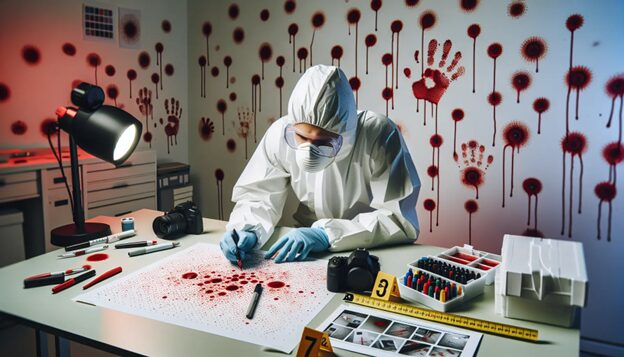
Blood spatter analysis, also known as bloodstain pattern analysis, is a critical tool used by forensic investigators in crime scene reconstruction. It involves the scientific examination of blood patterns at a crime scene to determine aspects of a violent event. By analyzing blood spatter, forensic experts can gather invaluable insights into what happened, how it happened, and potentially even who was involved. This blog will explain the science behind blood spatter analysis, the various types of patterns, what they reveal, and the challenges forensic analysts face when interpreting them.
What Is Blood Spatter Analysis?
Blood spatter analysis refers to the scientific examination of bloodstains to infer details about crimes involving physical trauma. Forensic scientists and forensic analysts study the shape, size, and distribution of bloodstains to reconstruct events that occurred during a crime. This discipline requires a strong understanding of biology, physics, and mathematics, as the mechanics of blood spatter adhere to scientific principles like fluid dynamics and gravity.
Focus Keyphrase: Blood Spatter Analysis
Blood spatter analysis often focuses on how external forces, such as blunt force trauma or gunshot wounds, create distinct bloodstain patterns. As one of the most revealing techniques in crime scene reconstruction, it allows crime scene analysts to work backward, piecing together the sequence of events that culminated in a blood-spattered room.
The Science Behind Blood Spatter Patterns
When a bloodstain is created, several factors influence its appearance, including the velocity of the blood, the surface it impacts, and the angle of impact. Forensic experts rely on these variables to determine how blood behaves under specific circumstances.
Forensic investigators use advanced software and tools to measure these variables and create accurate reconstructions of crime scenes.
Key Types of Blood Spatter Patterns
Each bloodstain pattern tells a unique story. Forensic specialists classify spatter into several categories for better interpretation. Below are the most common types:
These stains are formed when gravity alone influences the blood, such as when an injured person is stationary. Examples include pools and drips. Passive stains can indicate the absence of movement during an event.
These occur when a wet or bloodied object comes in contact with another surface. For instance, a bloody hand leaving a smear on a wall results in a transfer pattern. Transferred patterns often reveal the movement or direction of the assailant or victim.
When force is applied to blood, it creates projected stains. These include arterial spurts (caused by blood exiting the body under arterial pressure) or cast-off patterns (caused by blood flung from a moving object like a weapon).
As the name suggests, these stains occur when blood exits due to forceful impact. Gunshots, for example, produce both forward spatter (projected outward) and backspatter (traveling back toward the source of impact).
Sometimes, bloodstains form around an object or body, leaving a blank area. Void patterns help forensic analysts infer the position of objects during the crime and whether they were moved afterward.
What Blood Spatter Reveals About a Crime
Bloodstain analysis plays a pivotal role in solving cases. Through detailed observation, forensic scientists reveal critical details, such as:
Challenges in Blood Spatter Analysis
While the science of bloodstain pattern analysis has proven useful, it is not without its challenges. Some issues that forensic experts and crime scene analysts face include:
Despite these challenges, bloodstain analysis provides critical insights for forensic investigators working on cases involving violent crimes.
Conclusion
Blood spatter analysis combines rigorous scientific principles and meticulous observation to uncover vital evidence at crime scenes. Forensic investigators, forensic analysts, and crime scene specialists rely on this tool to reconstruct violent events, identify individuals involved, and provide clarity where chaos once reigned. As technology evolves, blood spatter analysis techniques will continue to refine our understanding of crime scene reconstruction.
Sources:
by Kourosh Nikoui | Feb 10, 2025 | Crime Scene
Forensic Practitioner and Specialist Kourosh Nikoui, Principal Consultant and CEO of Nikoui & Associates, Forensic Identification Services & Consulting, Inc., has over 38 years of full-time experience in forensic science and criminal justice with various law enforcement agencies, government and private entities. Mr. Nikoui, a court-qualified expert, is a Certified Latent Print Examiner, Certified Senior Crime Scene Analyst, and Certified Forensic Photographer by the International Association for Identification. He has testified as an expert witness over 150 times in California Superior and U.S. Federal Courts, processed evidence in over 30,000 criminal and civilian cases, and served as a consultant to numerous law enforcement agencies. Mr. Nikoui holds a BFA degree from USD and is an active member of multiple forensic science organizations. He can be reached directly by calling (866)439-6753 or by email at [email protected]. Please visit Mr. Nikoui’s website at www.nikouiandassociates.com. Mr. Nikoui’s CV can be viewed and downloaded at the bottom of the following web page: https://www.nikouiandassociates.com/kourosh-nikoui/